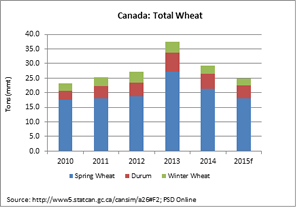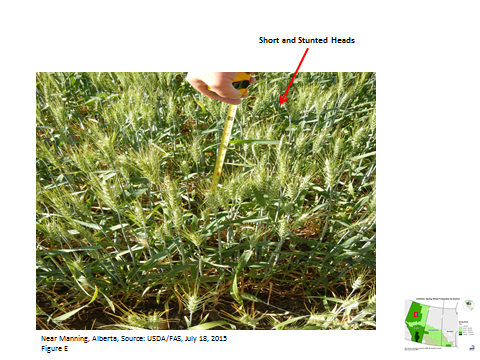Canada: 2015/16 Wheat Production Forecast Drops to Down 15 Percent from 2014/15
USDA forecasts total Canadian wheat production at 25.0 million metric tons (MMT), down 5.67 percent from the previous forecast, and down nearly 15 percent from 2014 because of adverse growing conditions. Harvested area is estimated at 9.6 million hectares, unchanged from the previous month, still up 1.5 percent from last year. Yield is estimated at 2.6 tons per hectare (MT/Ha) down 5.8 percent from the previous month and down 16 percent from last year.
Spring wheat, which comprises 72 percent of total wheat, is forecast at 18.0 MMT, down 15.31 percent from 2014. Yields are forecast to drop to 2.5 MT/Ha, down nearly 17 percent from a year ago. Durum, which  comprises 18 percent of total production, is expected to drop by nearly 14 percent despite an increase in seeded area. Poor soil moisture throughout the growing season in southwest Saskatchewan and southeast Alberta reduced yields. Winter wheat is forecast to reach 2.5 MMT, down 16 percent because of a drop in area seeded. comprises 18 percent of total production, is expected to drop by nearly 14 percent despite an increase in seeded area. Poor soil moisture throughout the growing season in southwest Saskatchewan and southeast Alberta reduced yields. Winter wheat is forecast to reach 2.5 MMT, down 16 percent because of a drop in area seeded.
Poor soil moisture contributed to yield reductions for both the spring and durum wheat crops in Canada. The western prairies did not receive significant rainfall during the critical growing stages. Although farmers were able to plant early (mid-May) due to dry conditions, there was not enough moisture for normal plant development (Figure A). Dry conditions persisted in June (Figure B) as the crop was emerging and going into flowering. Provincial reports highlight crops were under stress in June and early July. Alberta’s provincial report of June 29 stated that only 36 percent of the province had good to excellent soil moisture. Saskatchewan soil moisture for this same time period varied as good to excellent in north and central Saskatchewan but deteriorated in the southern and western areas. Soil moisture conditions further deteriorated in July across the western prairies except in Manitoba as the crop progressed from flowering and into the dough stage. (Figure C)
Surface Soil Moisture-Canadian Prairie, May 18-24,2015

Figure A
Figure B

Figure C

Poor soil moisture in the major spring wheat growing areas resulted in decreased yield potential. USDA/FAS personnel observed short, small heads and fields with low plant population due to dryness during a crop tour in mid-July. (Figure D and Figure E)

Figure D
Source: USDA/FAS, July 18, 2015

Figure E
Satellite-derived vegetative indices for July (Figure F) showed crop vigor as mixed across Alberta and Saskatchewan during grain fill and a few weeks before the start of harvest. The oval in the figure highlights poor conditions in Alberta. There are a few areas in western Peace River in Alberta, pockets in southern Alberta, north and central Saskatchewan showing normal to above normal crop vigor during flowering. Although these areas received adequate precipitation during the growing season, crop yields for Saskatchewan and Alberta are below normal. Growing conditions across southern Manitoba were good (Figure F) and may offset some potential loss in national yield.

Figure F
Storms and precipitation improved soil moisture across the Prairies as of late July; however, these storms came too late to boost yields as the crop was well past flowering. As of the end of August, harvest was beginning across the prairies and was about a week ahead of schedule. The Alberta August 28 provincial report estimated that spring wheat yields were down 23 percent from the 5-year average and Saskatchewan estimated wheat yields down by 33 percent from the 5-year average for the same time period.
This report has been published by the Office of Global Analysis (OGA), International Production Assessment Division (IPAD).
Current USDA area and production estimates for grains and other agricultural commodities are available on IPAD's Agricultural Production page or at PSD Online.
Visit Crop Explorer http://www.pecad.fas.usda.gov/cropexplorer/
|

